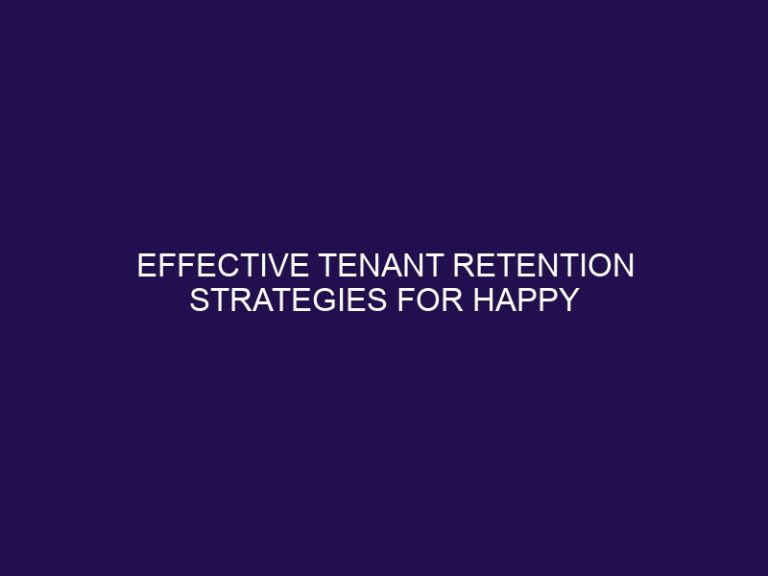Adapting to Market Fluctuations in Rental Pricing
Market fluctuations in rental pricing refer to the changes in rental rates for properties in a particular market over a period of time. These changes can be influenced by various factors such as supply and demand, economic conditions, and local market trends. Landlords must be prepared to adapt to these fluctuations in order to remain competitive and maintain profitability in the rental market.
Some factors that can cause market fluctuations in rental pricing include changes in the economy, shifts in demographic trends, and changes in supply and demand. For example, if there is an increase in job opportunities in a certain area, there may be a higher demand for rental properties, leading to an increase in rental rates.
So, how can landlords adapt to these market fluctuations in rental pricing? Here are some strategies to consider:
- Monitor Market Trends: Keep an eye on local real estate market trends, including rental rates and vacancy rates. This will help you make informed decisions when it comes to setting rental rates for your properties.
- Consider Flexible Lease Terms: Offering flexible lease terms, such as month-to-month or short-term leases, can help attract tenants in a highly competitive market. It also allows you to adjust rental rates more frequently if needed.
- Offer Incentives: Incentives such as discounts or upgrades can help attract tenants and stay competitive in the market.
- Focus on Tenant Retention: Keeping good tenants is crucial for maintaining occupancy rates and avoiding costly turnover. Consider offering lease renewals at a discounted rate or with added benefits to encourage tenants to stay.
Adapting to market fluctuations in rental pricing can have various benefits for landlords:
- Maintains Occupancy Rates: By staying competitive with rental rates, landlords can attract and retain tenants, maintaining high occupancy rates.
- Increases Profitability: Adjusting rental rates according to market fluctuations can help landlords maximize their profits and stay ahead of inflation.
- Attracts Quality Tenants: With competitive rental rates, landlords can attract high-quality tenants who are willing to pay for a well-maintained property.
On the other hand, not adapting to market fluctuations can have negative consequences for landlords, such as:
- Increased Vacancy Rates: If rental rates are too high compared to the market, landlords may struggle to find tenants, leading to higher vacancy rates.
- Decreased Profitability: Not adjusting rental rates in line with market fluctuations can result in lower profits for landlords.
- Difficulty Attracting Tenants: In a competitive market, setting rental rates too high can make it challenging to attract tenants, leading to longer vacancy periods.
To stay informed about market fluctuations in rental pricing, landlords can:
- Research Local Real Estate Market: Keep up with local real estate market trends by attending industry events and networking with other professionals.
- Utilize Online Tools and Resources: There are numerous online tools and resources available that can provide valuable insights into local market trends and rental rates.
- Network with Other Landlords and Industry Professionals: Joining landlord associations or networking with other professionals in the industry can help landlords stay informed about market fluctuations and share best practices.
What Are Market Fluctuations in Rental Pricing?
What Are Market Fluctuations in Rental Pricing?
Market fluctuations in rental pricing refer to the changes in rental rates influenced by factors like demand, supply, and economic conditions. Understanding these fluctuations helps landlords adjust rents strategically. Pro-tip: Regularly monitor local real estate trends to anticipate and adapt to rental price changes effectively.
What Causes Market Fluctuations in Rental Pricing?
What Causes Market Fluctuations in Rental Pricing?
Factors such as demand-supply dynamics, economic conditions, and local development can all contribute to fluctuations in rental pricing. These changes can be influenced by shifts in population, job opportunities, and housing supply, which have a significant impact on rental prices.
How Can Landlords Adapt to Market Fluctuations in Rental Pricing?
As a landlord, navigating market fluctuations in rental pricing can be a daunting task. However, there are ways to adapt and stay competitive in a changing market. In this section, we will discuss various strategies that landlords can implement to adjust to market trends and maintain a profitable rental business. From monitoring market trends to offering incentives, we will explore different approaches to finding success in a fluctuating rental market.
Monitor Market Trends
- Monitor real estate reports and rental publications regularly.
- Utilize online platforms for rental price comparisons and market analysis.
- Engage in discussions with local real estate associations and professionals.
Staying updated with market trends is crucial for making informed rental pricing decisions.
Consider Flexible Lease Terms
Consider implementing flexible lease terms to adjust rent prices based on market shifts. This can include offering shorter lease durations or rent adjustments to retain tenants.
Pro-Tip: Incorporating lease flexibility can enhance tenant satisfaction and attract long-term renters, ultimately promoting stability in rental income.
Offer Incentives
Offering incentives, such as discounted rent for long-term leases, free parking, or utility subsidies, can be an effective way to attract and retain tenants. This can help mitigate the impact of market fluctuations in rental pricing.
Focus on Tenant Retention
To enhance tenant retention, landlords can provide incentives for lease renewals, cultivate positive relationships with tenants, and promptly address any concerns. According to a survey conducted by the National Multifamily Housing Council, prioritizing tenant retention can result in a 20% reduction in turnover costs.
What Are the Benefits of Adapting to Market Fluctuations in Rental Pricing?
As a landlord or property manager, it is essential to adapt to market fluctuations in rental pricing in order to stay competitive and maximize profits. In this section, we will discuss the various benefits of adapting to changes in the rental market. From maintaining high occupancy rates to attracting quality tenants, adjusting rental prices can have a significant impact on the success of a rental property. Let’s dive into the advantages of staying flexible and responsive to market trends.
Maintains Occupancy Rates
- Consistent Maintenance: Maintaining high occupancy rates by promptly addressing tenant concerns and ensuring competitive pricing.
- Effective Communication: Establishing open lines of communication to swiftly address any tenant concerns.
- Competitive Pricing: Staying informed about local rental rates to offer competitive pricing.
A Chicago property owner has successfully maintained high occupancy rates by consistently addressing tenant concerns and offering competitive pricing. This proactive approach has fostered long-term tenant relationships and positive word-of-mouth referrals, contributing to sustained occupancy rates.
Increases Profitability
Adapting to market fluctuations in rental pricing has the potential to significantly increase profitability by optimizing rental income, reducing vacancy periods, and attracting long-term, quality tenants.
Attracts Quality Tenants
Attracting quality tenants requires the upkeep of well-maintained properties, offering desirable amenities, and providing exceptional customer service. Landlords can also highlight positive tenant reviews and emphasize the distinctive features of their rental properties to attract quality tenants.
What Are the Risks of Not Adapting to Market Fluctuations in Rental Pricing?
In the ever-changing real estate market, rental pricing is subject to fluctuations that can greatly affect the success of a rental property. In this section, we will discuss the potential risks that landlords face when they fail to adapt to market fluctuations in rental pricing. These risks include increased vacancy rates, decreased profitability, and difficulty attracting tenants. It is crucial for landlords to understand and respond to these risks in order to maintain a successful and profitable rental property.
Increased Vacancy Rates
High vacancy rates can have a negative financial impact on landlords, affecting their cash flow and profitability. To avoid this risk, landlords should prioritize proactive tenant retention strategies, including providing lease incentives and improving property amenities, in order to maintain a high level of occupancy.
Decreased Profitability
Decreased profitability can occur due to high vacancy rates, lower rental income, and increased marketing costs. In order to mitigate the impact of decreased profitability, landlords must adapt by adjusting rental rates, offering incentives, and prioritizing tenant retention.
Difficulty Attracting Tenants
During market fluctuations, landlords may encounter challenges in attracting tenants as competition increases, resulting in longer periods of vacancy. To address this issue, landlords can improve the appeal of their property, provide desirable amenities, and adjust rental rates according to market demand and the preferences of potential tenants.
How Can Landlords Stay Informed About Market Fluctuations in Rental Pricing?
As a landlord, it is crucial to stay informed about market fluctuations in rental pricing to ensure competitive and profitable rental rates. In this section, we will discuss the various ways in which landlords can stay updated on market trends and pricing changes. From researching the local real estate market to utilizing online tools and networking with other professionals in the industry, we will explore the strategies that can help landlords adapt to and navigate market fluctuations in rental pricing.
Research Local Real Estate Market
- Explore local property listings and rental prices.
- Analyze historical and current rental data in the target area.
- Engage with local real estate agents to gain insights about the local real estate market.
- Attend property auctions and open houses to gauge market demand and research the local real estate market.
Utilize Online Tools and Resources
- Stay updated by subscribing to real estate market websites and forums.
- Make use of online rental pricing analysis tools such as Rentometer or Zillow.
- Access local government housing reports and statistics for valuable insights.
One successful landlord utilized Zillow to monitor rental trends and make prompt adjustments to lease rates, resulting in higher tenant satisfaction and improved profitability of their property.
Network with Other Landlords and Industry Professionals
- Attend industry conferences and workshops to network with other landlords and professionals.
- Join online forums and social media groups dedicated to rental property management to connect with others in the industry.
- Participate in local real estate investment clubs or associations to expand your network of fellow landlords and professionals.
Frequently Asked Questions
1. What factors can cause fluctuations in rental prices for multi-family homes?
The leased percentage of a building, seasonality, market conditions, and unique property features can all influence rental prices for multi-family homes.
2. How have rental prices changed since the beginning of the pandemic?
Since the beginning of the pandemic, rental prices have increased by 29.4% overall, with single-family homes seeing a 35.7% increase and multi-family homes seeing a 23.3% increase.
3. Is the rental market currently stable or still experiencing growth?
According to the most recent rental report, the rental market has stabilized compared to the beginning of the pandemic, with annual rent growth at 3.3% and a current average rent of $1,982 in November 2023.
4. How has the growth of new multifamily construction affected rental listings?
The growth of new multifamily construction has led to more rental listings offering concessions, causing a slowdown in rent growth and making it more affordable to rent rather than buy.
5. Which cities in the U.S. have seen the highest annual rent increases for all types of rental housing?
According to Zillow’s analysis, the top five cities with the highest annual rent increases are Providence (+7.3%), Hartford (+7.2%), Cincinnati (+6.4%), Columbus (+5.8%), and St. Louis (+5.7%).
6. How can renters stay informed and make the best decisions in a competitive rental market?
Renters can seek help from experienced professionals and stay flexible in their apartment search, as understanding market conditions and unique property features can help them make informed decisions and secure the best deal.







